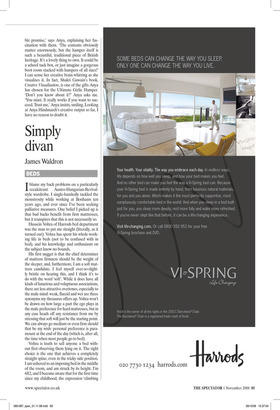Simply divan
James Waldron
BEDS
Iblame my back problems on a particularly recalcitrant Austro-Hungarian-Revivalstyle wardrobe. I single-handedly tackled the monstrosity while working at Bonhams ten years ago, and ever since I’ve been seeking palliative measures. One belief I picked up is that bad backs benefit from firm mattresses, but it transpires that this is not necessarily so.
Hussein Vohra of Harrods bed department was the man to put me straight (literally, as it turned out). Vohra has spent his whole working life in beds (not to be confused with in bed), and his knowledge and enthusiasm on the subject know no bounds.
His first nugget is that the chief determiner of mattress firmness should be the weight of the sleeper, and, furthermore, I am a soft mattress candidate. I feel myself ever-so-slightly bristle on hearing this, and I think it’s to do with the word ‘soft’. While it does have all kinds of luxurious and voluptuous associations, there are less attractive overtones, especially to the male mind: weak, flaccid and wet are three synonyms my thesaurus offers up. Vohra won’t be drawn on how large a part the ego plays in the male preference for hard mattresses, but in any case heads off any resistance from me by stressing that soft will just be the starting point. We can always go medium or even firm should that be my wish: personal preference is paramount at the end of the day (which is, after all, the time when most people go to bed).
Vohra is loath to sell anyone a bed without first observing them lying on it. The right choice is the one that achieves a completely straight spine, even in the tricky side position. I am ushered to an imposing bed in the middle of the room, and am struck by its height. I’m 6ft2, and I become aware that for the first time since my childhood, the expression ‘climbing into bed’ seems appropriate. Once horizontal, I am shocked to find this soft mattress is absolutely perfect. Not only does it pass the backbone test, but it’s the most comfortable bed I’ve ever come into contact with: luxuriously soft, and yet with no hammock-like sag. Ah, says Vohra, that’s because of the mattress’s dual personality: the hard-working innards that provide all the support (by way of steel springs and horsehair) are surmounted by a cosseting layer of mohair, lambswool, and cashmere teased together. This is beginning to sound pricey, and indeed it turns out I am atop only the most expensive bed in the store, and possibly the world: Vi-Spring’s fittinglynamed Monarch, coming in at an impressive £25,676, not including headboard.
Reluctantly sliding down from the magnificent beast, I broach the subject of the Monarch’s regal height. Although you can just buy the mattress, I’ve been testing the complete kit, incorporating a full-depth sprung divan. This turns out to be the second critical issue after firmness: divan or not divan, that is the question. While deep divans do give off a certain 1950s glamour, if you’re after a stylish bed, whether antique or modern, chances are you’ll be looking at a slatted base, allowing a bed to be low to the floor and/or show some leg. Vohra is of course delighted whichever option his customers decide upon, but he is just a touch dismissive of the ‘designerled trend’ in slatted bases. His interest in beds is as purveyors of perfect sleep, not as fashion items, and he believes divans should not be written off lightly, comparing them to the shock-absorbers in a car.
All Vi-Spring mattresses are made to order and made to last (those that graced the Titanic on her fateful journey had the shortest life in the company’s history). Founded in 1901, Vi-Spring was the first company in the ��� ������� �������� world to produce a mattress with individually pocketed springs, and to this day these remain at the heart of their every mattress, and indeed of the company itself. ‘Vi’ represents, in Roman numerals, the number of convolutions in every steel spring. Every single other material used in the manufacture is natural, and Vi-Spring beds are made entirely by hand in Devon.
Time is short, but I squeeze in a quick lie-down on some memory foam. This stuff’s all the rage, but Vohra stresses it’s no oneseason wonder, and many a bad back has been comforted by its mould-to-the-body properties. Its providence is impeccable, developed as it was in Sweden for Nasa, its cost of manufacture only very recently descending from the stratosphere, making it available to the public.
Harrods’ memory foam mattress is extremely comfortable, but as I bid Vohra farewell, I know it’s the Monarch which gets my vote (if indeed one can vote for a monarch). The only thing my dream bed now lacks is a headboard, and on this I have already made one decision: it will definitely not be anything in the Austro-Hungarian Revival taste.



































































































 Previous page
Previous page